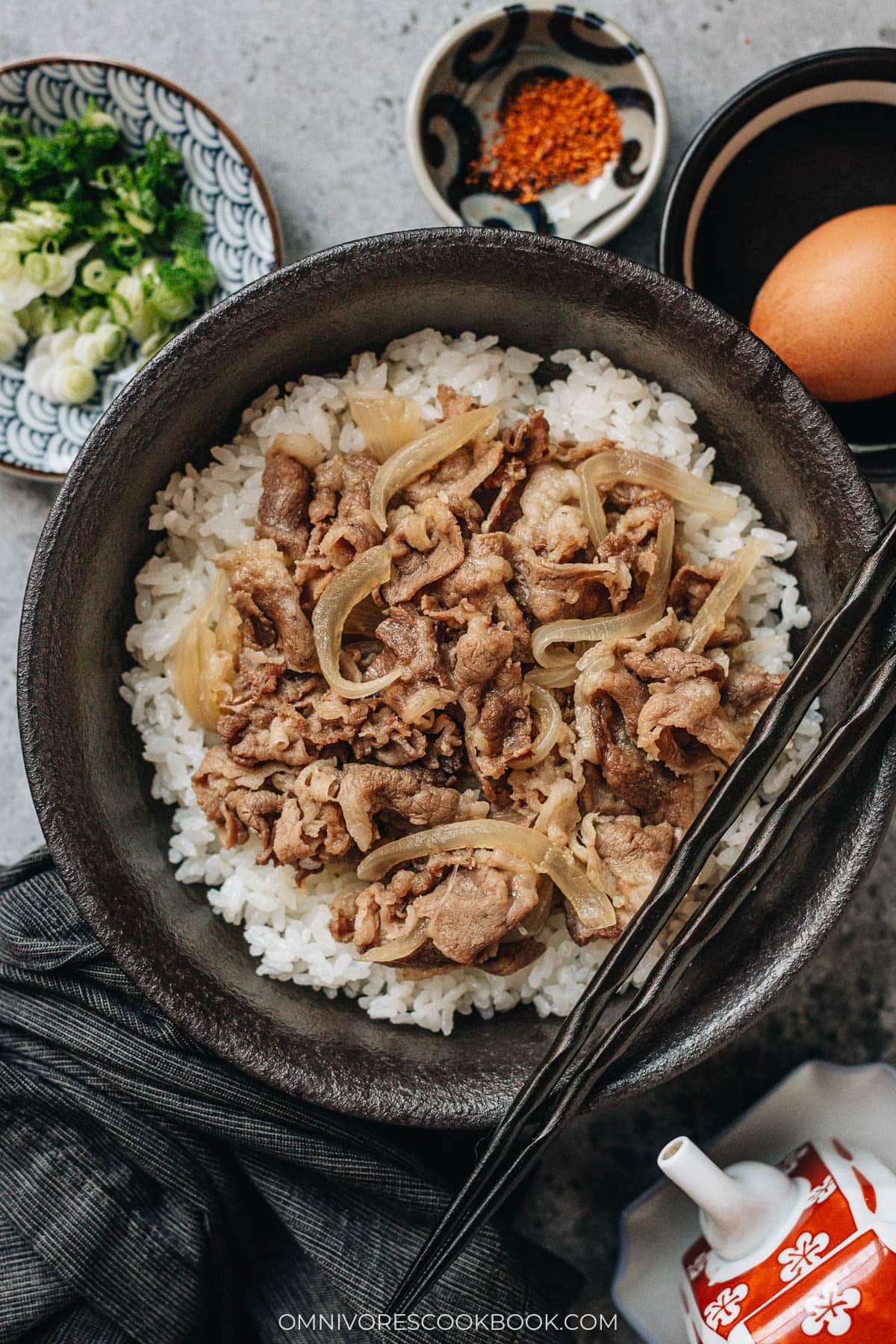
My first experience with gyudon was when Yoshinoya came to China in the early 90s, and it soon became one of my favorite options for a quick lunch. When I was living in Japan during my grad school years, gyudon from Yuskiya was a nice indulgence when I didn’t want to cook at home. That steaming bowl thinly sliced beef and onion simmered in a soy and mirin based sauce over a mound of rice. It was filling, delicious, and cheap. So much so that my friends and I often grabbed a beef bowl to fuel up before a night out (a smart trick, since dining at izakayas was pricey!).
Years later, back home, I still crave that same cozy beef bowl. After plenty of testing, I’ve perfected an authentic gyudon recipe that brings me right back to Japan.
What is gyudon
Gyudon (牛丼), often translated as “beef bowl,” is a classic Japanese rice bowl dish. It consists of thinly sliced beef and onion simmered in a sweet and savory broth and then served over a bowl of hot rice. Part of gyudon’s appeal is how quick and convenient it is. It’s essentially Japanese fast food, beloved by students and office workers alike for a speedy, filling meal.
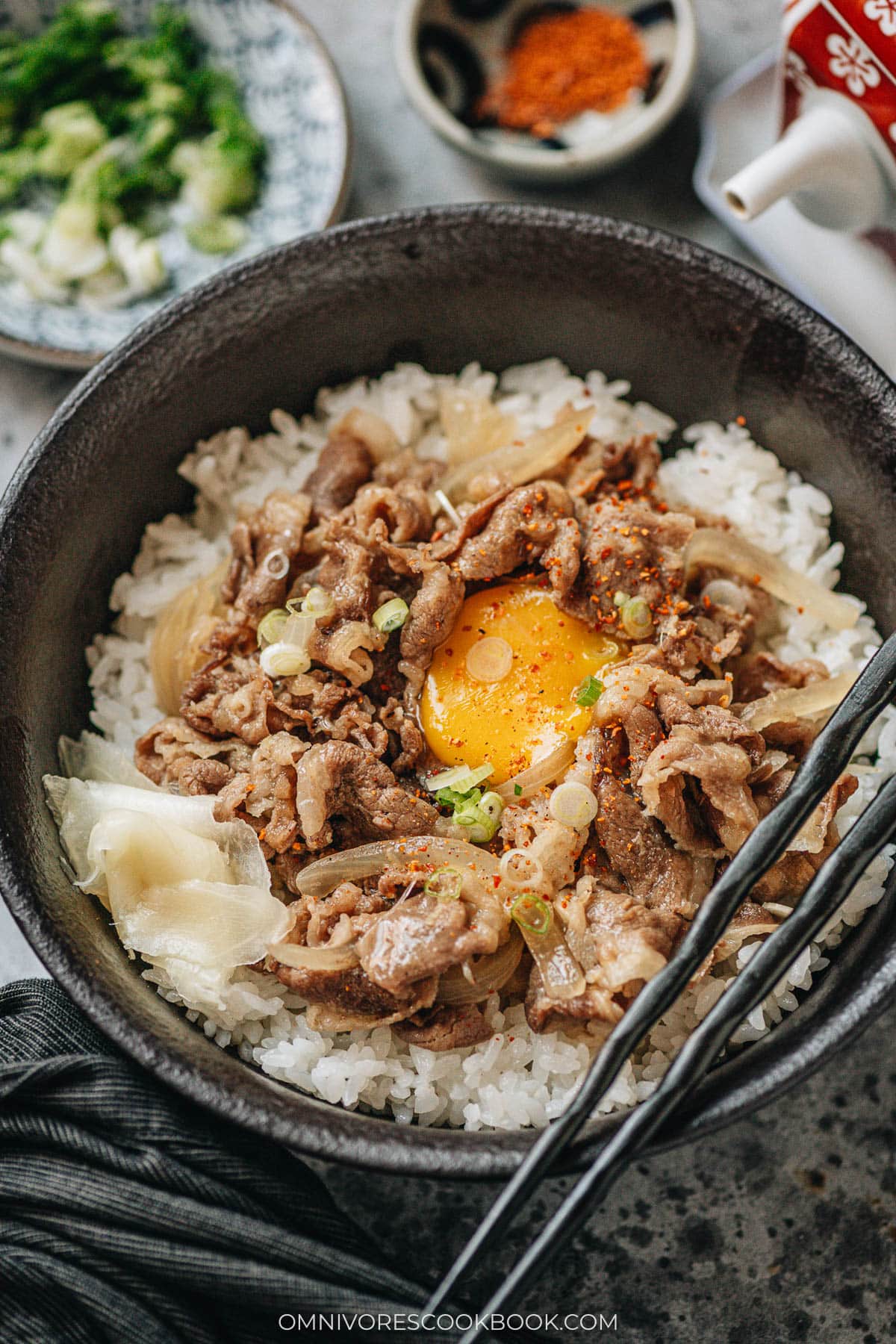

Ingredients
The type of beef to use
This is the most important part of the dish to help you achieve the restaurant-like result. If possible, select the most thinly sliced very fatty beef you can. You can find this pre-sliced beef at large Asian, Japanese, Korean and Chinese markets. Depending on the store, it can be sold as beef slices for shabu shabu, sukiyaki, or hot pot.
My personal favorite is the fatty ribeye slices from Chinese markets. The paper thin sliced meat is rolled up nicely and usually sold frozen. The fat ratio could be anywhere from 30% to 50%. When you use this type of cut, the fat melts into the broth during cooking and the lean part becomes buttery tender. You simply won’t get the same effect using thicker slices, or if the beef is too lean.
Another great option is to get beef kiriotoshi, a combination of lean and marbled meat often sold at Japanese markets. It is usually cheaper and you might be able to find very nicely marbled ones that are perfect for this dish.
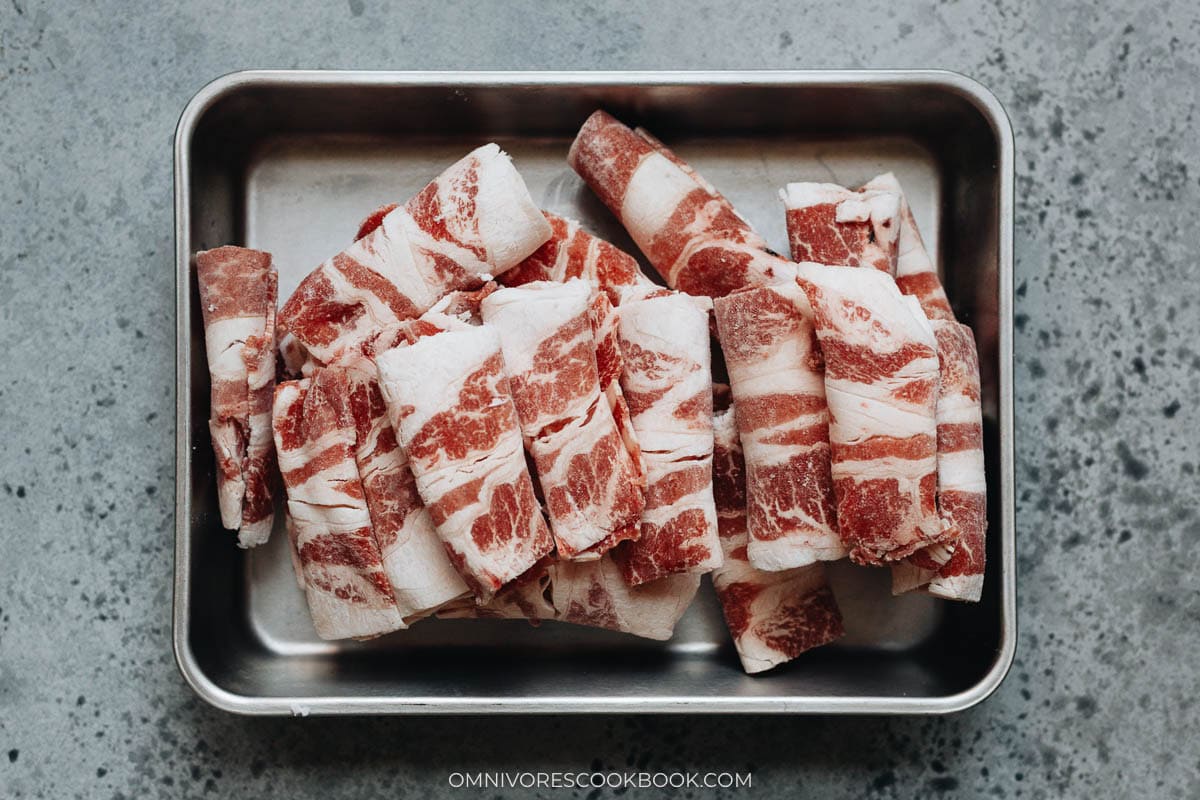

That being said, if you do not have access to any pre-sliced cuts, check out how to slice meat for Japanese cooking by Just One Cookbook.
Dashi Kombu
Dashi is a traditional ingredient used in gyudon to add a savory umami to the broth. In many recipes, regular dashi (or instant dashi) made from bonito flakes and kombu is commonly used. But I learned this method from my favorite Japanese chef Kasahara Masahiro (笠原将弘), using only kombu to create the dashi base during the braising process. Since we’re already using beef, we essentially create a beef kombu dashi that has a nice clean flavor without using any fish ingredients.
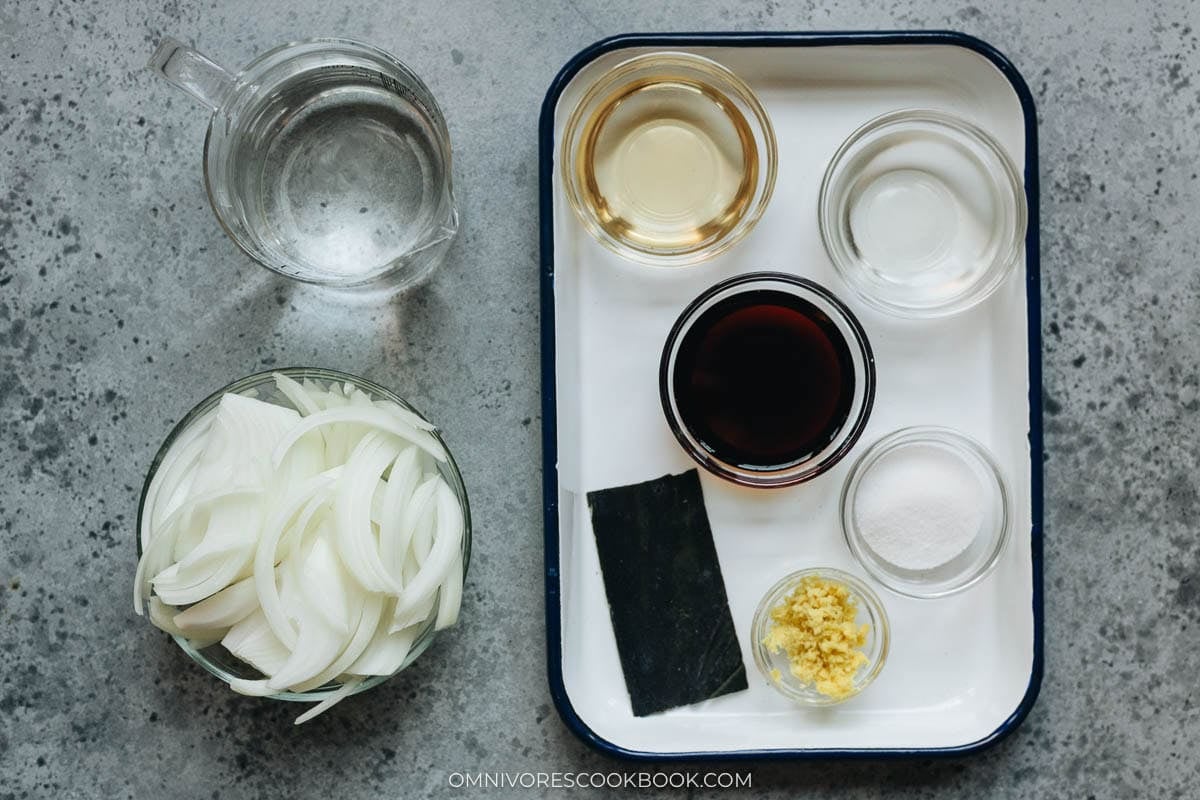

Broth ingredients
The gyudon broth usually uses a default combination of soy sauce, Japanese sake, mirin and sugar. And the ratio is 2:2:2:1.
For the best result, I follow chef Kasahara’s suggestion to use usukuchi soy sauce, or Japanese light soy sauce. It is lighter colored than regular soy sauce, with a saltier taste. Compared to Chinese light soy sauce, it tastes less salty and less intense. If you do not have this ingredient, use a regular Japanese soy sauce for the best result.
Also make sure you use high-quality sake that you enjoy drinking, instead of cooking wine. It makes a big difference in terms of flavor.
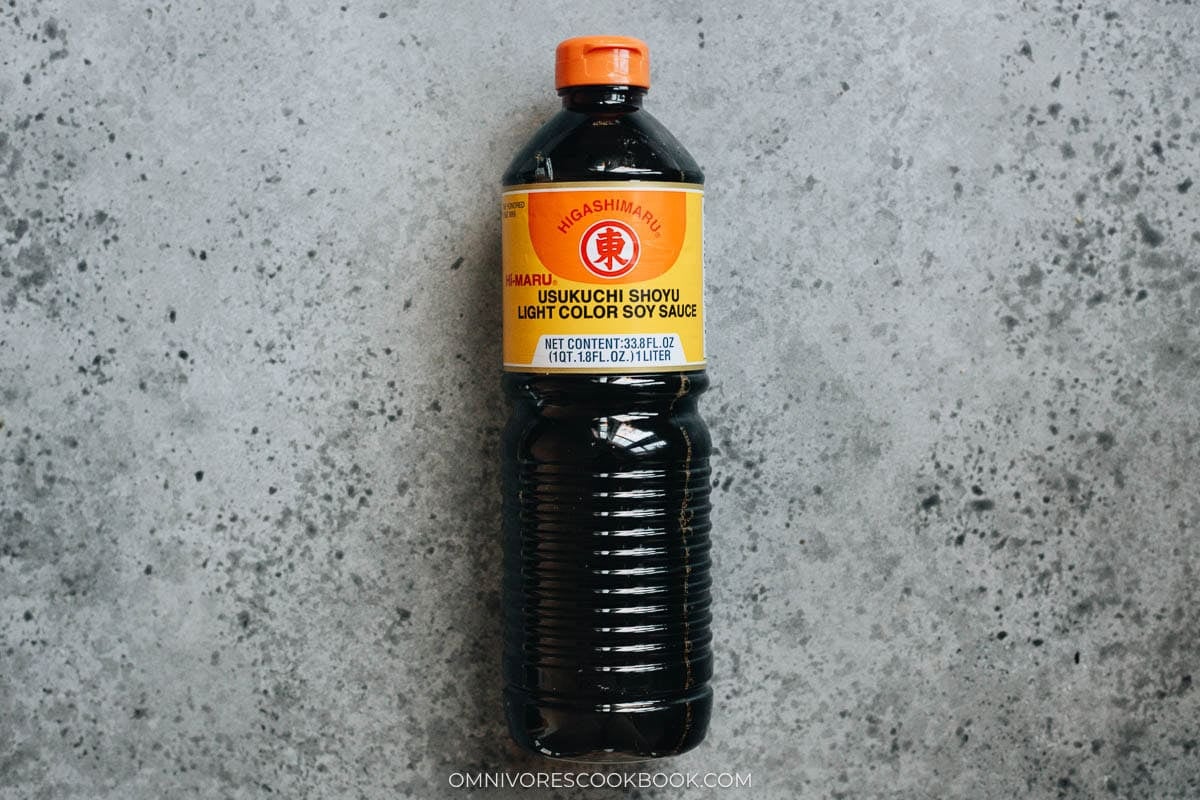

What type of rice to use
Use short grain (or sometimes labeled sushi rice in the US) for the most authentic result.
How to make
Start cooking by simmering the kombu and onion in the broth ingredients for 10 minutes. This process makes dashi from the kombu and gives the onion an extra tender texture.
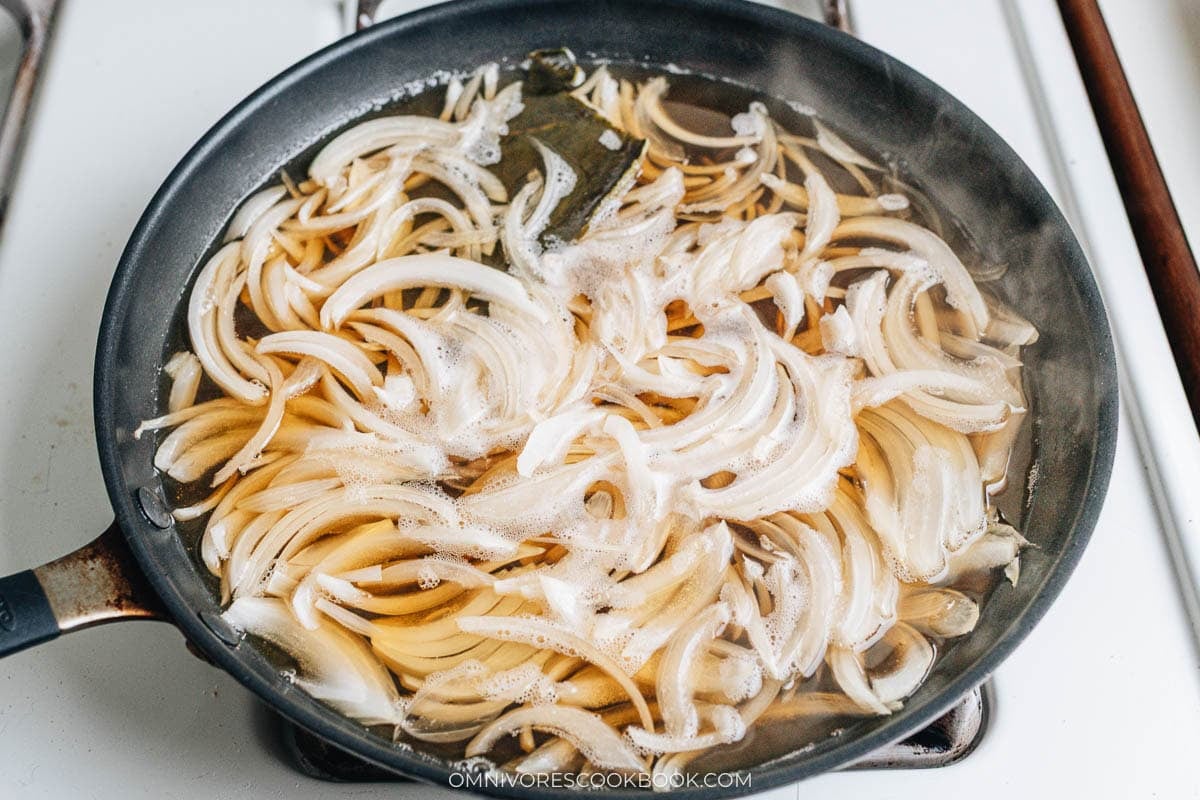

Then add the beef. While adding the thinly sliced beef, be sure to spread out each piece (I like to use a pair of chopsticks) so it does not stick together or curl up. This ensures even cooking. Turn up the heat to bring up the beef temperature until brown foam starts to show on top of the broth. Skim off and discard the foam. You will also skim off a lot of fat during this process, making the broth clearer.
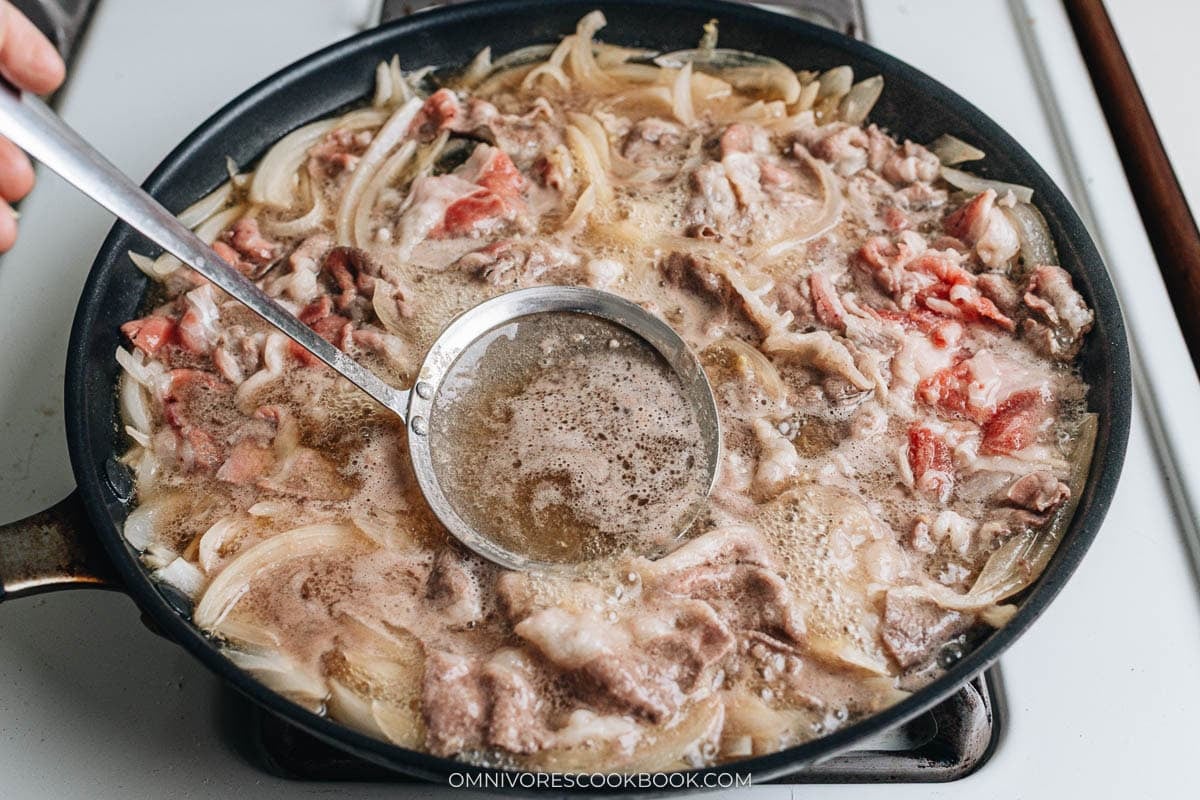

Cover and simmer for 8 minutes. After simmering covered, simmer uncovered for another 7 minutes. The total simmer time is 15 minutes, which might look longer than some of the other online recipes. But I found that long braising is the best way to get the beef really tender, the fat dissolved, and the meat really soaks up the flavor of the dashi.
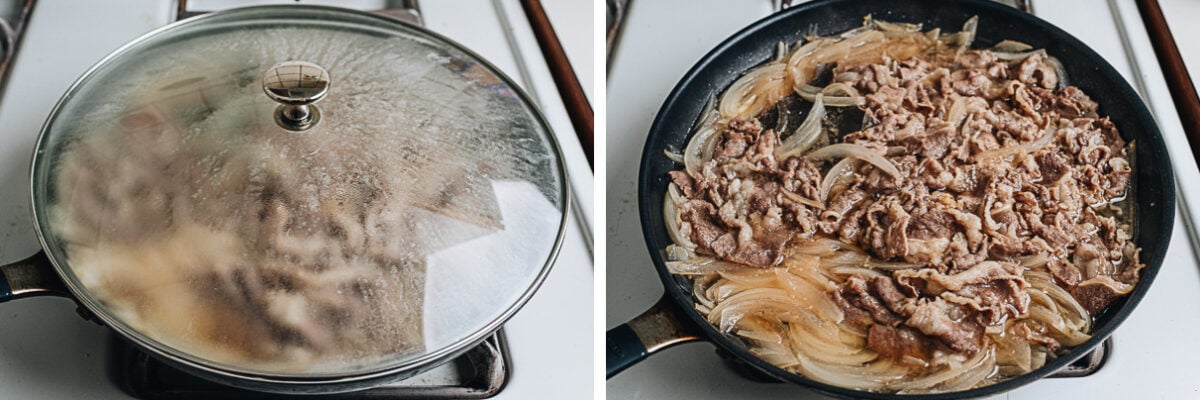

During the last part of the simmering, I would keep skimming the fat from the top. The last part also reduces the broth and makes it a little more concentrated. By the end of the braising, the broth should have reduced by about half, with the beef and onion super tender.
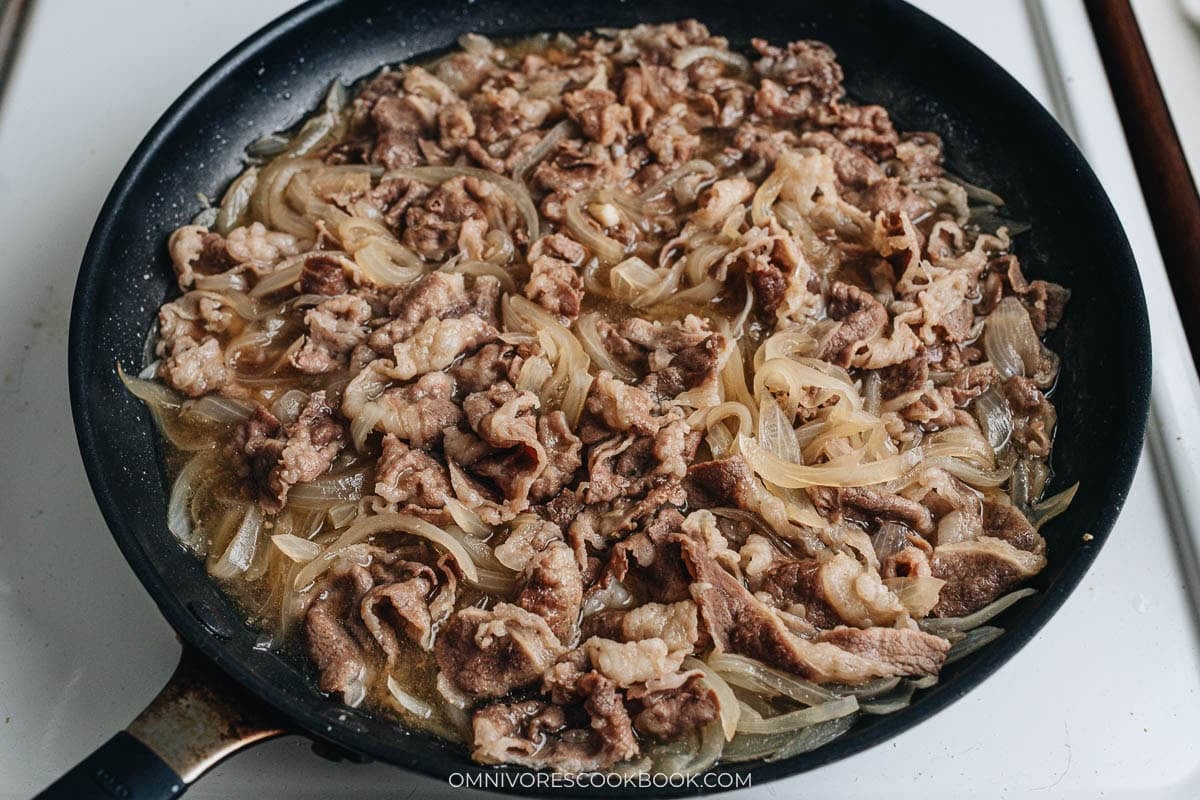

A word about cooking pots
In Japan, the default cooking pot for gyudon is a large skillet. Because it offers the largest surface area to make sure all the beef slices are emerged in the broth to soak up the flavor. A shallow skillet also makes it easier to skim the foam and fat from the top. If you’re making a bigger batch by doubling the recipe, a large dutch oven will be a good option as well.
How to serve
To serve gyudon, add rice to each serving bowl, then add some beef and broth on top. Depending on how much the broth has reduced and on your personal preference, you can adjust the seasoning by adding more broth to your bowl.
Topping options
Gyudon is usually enjoyed with pickled red ginger on top as a default. Its tangy bite perfectly balances the savory-sweet beef. But when I have this dish in Japan, I love that restaurants often offer many topping options to personalize the bowl. Here are some of my favorites:
- Pickled ginger: It’s almost a must-have, but since I do not like food dye, I used natural pickled ginger instead of the pink one.
- Egg: Stirring a raw egg yolk, whole egg, or onsen tagamo (hot spring egg) into the rice creates an incredibly rich, silky texture.
- Scallion: It adds freshness and contrast to the bowl.
- Shredded cheese: It used to be my favorite topping! Thinly shredded cheese will melt immediately when you stir it into the piping hot beef rice, creating a silky mouthfeel similar to the effect of the eggs. If possible, use the thinnest shredded cheese you can find, to speed up the melting process.
- Shichimi togarashi: Japanese seven spice adds some heat to the dish. Because the blends often also contain orange peel, sesame seeds, sansho, seaweed, ginger, and poppy seeds, it adds zesty and savory umami that works well with the slightly sweet dish.
- Kimchi: Another option instead of pickled ginger, to add a tangy contrast and some heat.
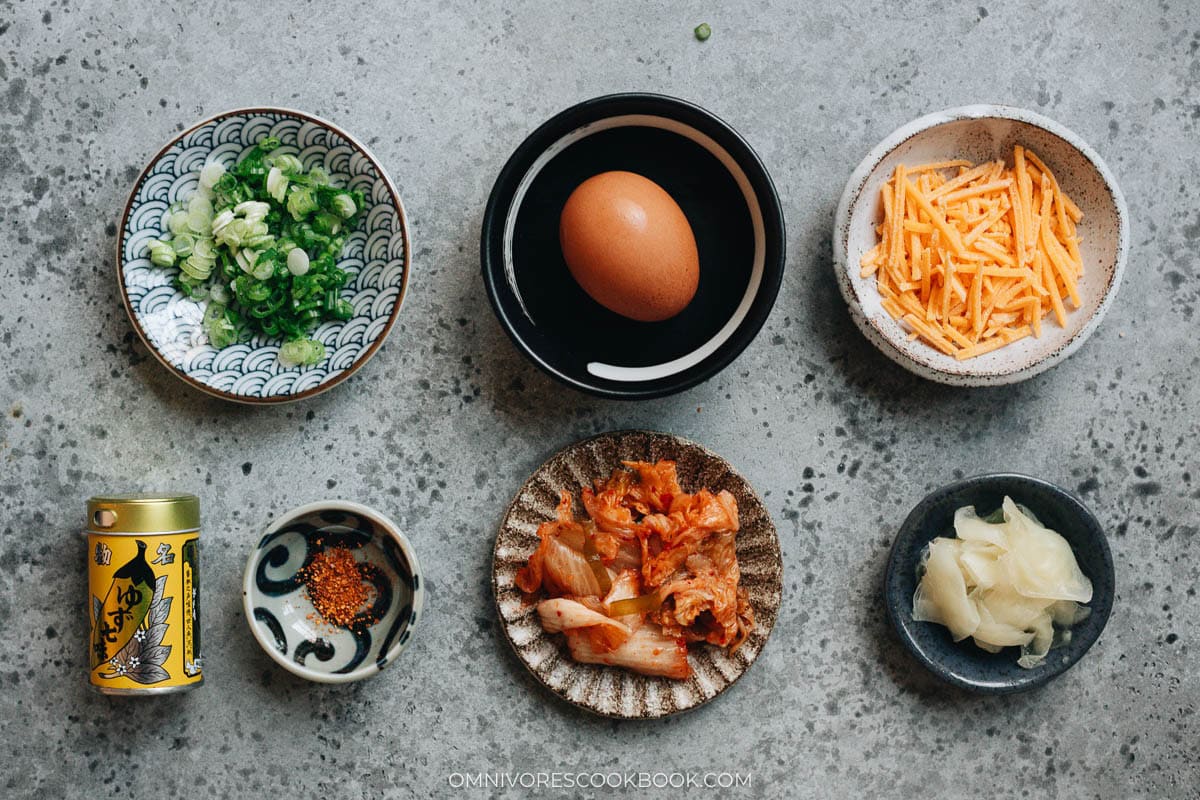

Make ahead
Gyudon is a great dish for meal prep or if you want to make a bigger batch for later. In Japan, it’s a dish that’s frequently used in bento boxes. Due to the slightly sweet broth, the dish tastes really good even when it’s at room temperature (if you do not have a way to heat it up).
This recipe uses slow braising so you will get a very flavorful bowl right after cooking. But if you let the beef sit in the broth for a couple of hours or overnight, the flavor blends in more and it will taste even better.
Frequently asked questions
What cut of beef should I use for Gyudon?
If you decide to slice your own beef instead of purchasing the pre-sliced type, try to find fatty and well marbled cuts such as ribeye or short plate. The fattier and more marbled the beef, the better the results you will get.
Can I make Gyudon without thin-sliced beef?
Yes. If you can’t find thinly sliced beef, you can partially freeze a steak for 30 to 45 minutes and then slice it thinly with a sharp knife. When slicing beef at home, do not try to achieve large slices like the pre-sliced type. Because it’s almost impossible to create even slices without a meat slicer. By slicing smaller pieces, you have a higher chance of cutting very thin slices that are more even.
Some people use ground beef for a budget-friendly version, though it changes the texture.
Can I use regular soy sauce instead of Japanese soy sauce?
Yes, but Japanese soy sauce (such as Kikkoman or Yamasa) is slightly lighter and more balanced. If you use Chinese light soy sauce, your dish might come out stronger tasting and saltier.
Why does your recipe simmer the beef for so long?
There are two approaches to cooking paper-thin beef – briefly cooking until the beef is just cooked through (2 minutes or so), or a longer braise to break down their tissues so they’re tender. I’ve tried both and found that long braising is the only way to recreate the rich restaurant flavor. That’s also why you will need very fatty beef cuts in this dish, since lean beef will become dry and tough if cooked for so long.
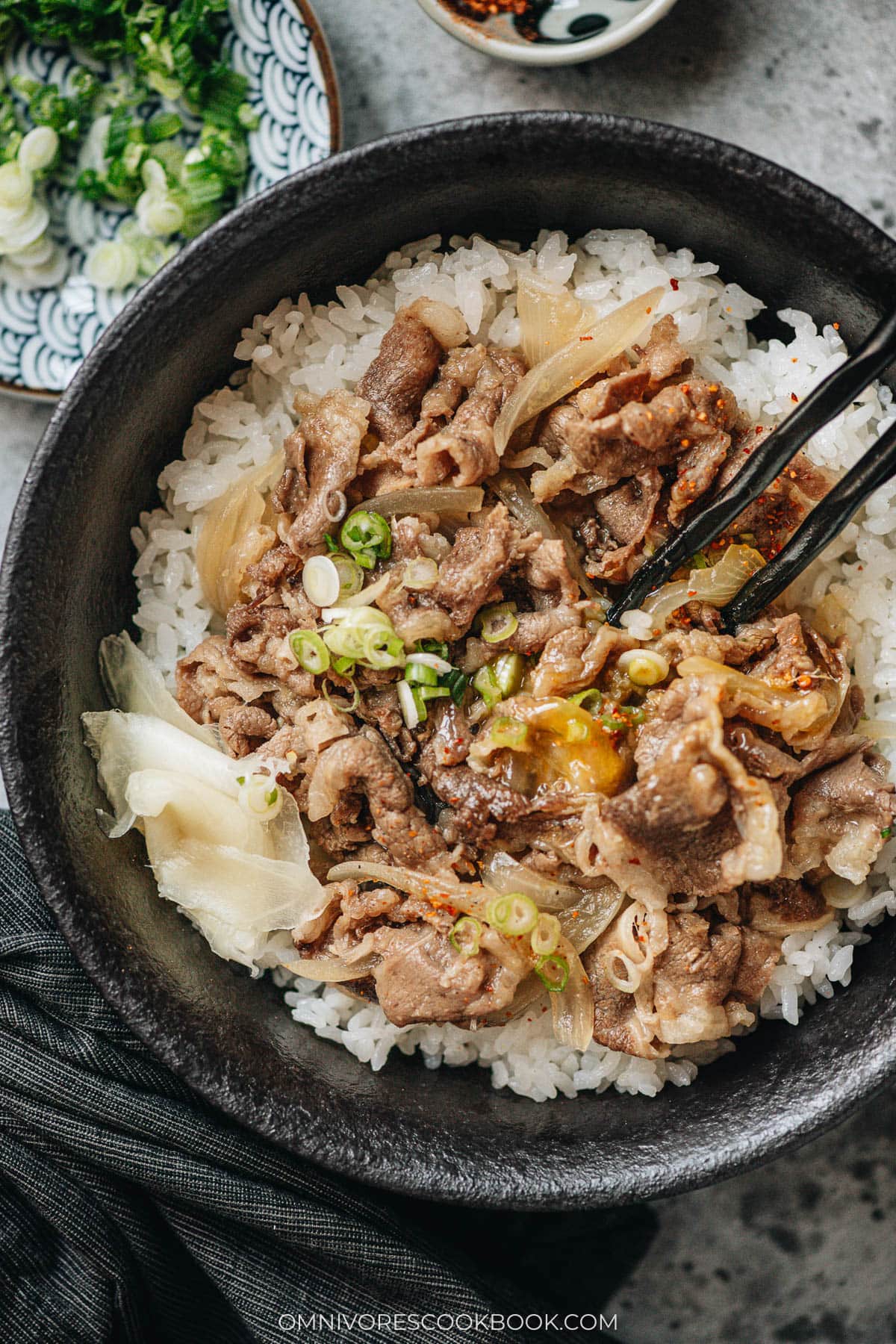

Other Japanese recipes you might enjoy
Chinese Cooking Made Easy
Are you new to this website? This free email series is a great place to start. I’ll walk you through a few of my most popular recipes and show you how and why they work. You’ll quickly start to cook better Chinese food in your own kitchen.
My gyudon recipe shows you all the tips to create a hearty Japanese beef rice bowl with tender beef and a savory sweet broth full of umami. It’s easy to put together and tastes even better the next day.
Prevent your screen from going dark
-
Combine water, kombu, soy sauce, Japanese sake, mirin, sugar and onion. Cook over medium heat until bringing to a boil. Turn to medium-low heat and simmer for 10 minutes, until onion has softened.
-
Add the beef and grated ginger. Cook over medium heat until the broth is boiling again. Skim off and discard any brown foam from top, for 2 to 3 minutes, until no new foam is forming. Turn to medium-low heat and simmer covered for 8 minutes. Then simmer uncovered for another 7 minutes, until the broth has reduced by half. During the simmering, you can further skim off any oil from the surface.(*Footnote 4) You can serve the beef now. But it will be tastier if you let the broth cool off a bit, so the beef soaks up the flavor more.
-
To serve, portion rice into each serving bowl. Add the beef with some broth. Garnish with pickled ginger and any other toppings you prefer. Enjoy as a main dish.
- Japanese light soy sauce (Usukuchi soy sauce, 薄口) is the best. If not available, use regular soy sauce.
- The thinner and fattier the beef, the better the result. I prefer the type of rolled up frozen sliced beef, usually labeled for hot pot or sukiyaki (usually found at Chinese or large Asian markets) because it is extra thin and fatty. You can also find sliced beef at Japanese and Korean markets. If none is available, check out how to slice meat thinly by Just One Cookbook.
- For the most authentic presentation, use red pickled ginger. I do not like food coloring personally so I used pickled ginger without dyes.
If you use a fatty cut of beef, similar to the one I used in this recipe, the beef will release a lot of fat during cooking. I skimmed off about 1/3 cup fat during the cooking.
Serving: 1serving, Calories: 637kcal, Carbohydrates: 88.2g, Protein: 29.5g, Fat: 15.9g, Saturated Fat: 6g, Trans Fat: 0.4g, Cholesterol: 88mg, Sodium: 1270mg, Fiber: 1.4g, Sugar: 18g


Did you make this recipe?
I’d love to hear how it turned out for you! Please take a moment to leave a 5-star rating ⭐️ and share your thoughts in the comments further down the page. It really helps others discover the recipe too.
And if you snapped a photo, don’t forget to tag @omnivorescookbook on Instagram. I can’t wait to see your creations!





